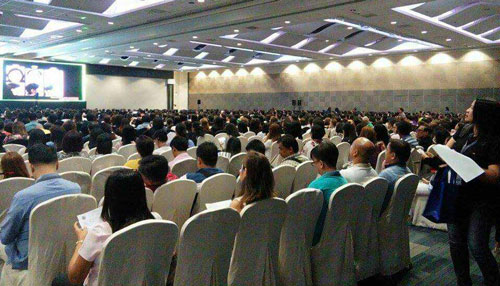As part of the Ortho Symposium, APO fellow Dr. Cecile Tuano Cabrera gave a lecture on the “Current approaches to the orthodontic management of cleft lip and palate in children and adults” last May 3, 2017 at the scientific session of the 108th Philippine Dental Association.
The lecture included an introduction regarding the classification, epidemiology and problems caused by cleft lip and palate (CLAP); overall cost and timing of treatment; an overview of the services of Noordhoff Craniofacial Foundation Philippines, Inc. (www.ncfphil.org); and different treatment approaches for patients with clefts at different stages –at age 0 to 3 months, during primary dentition, during mixed dentition and during the adult dentition. Photos of patients treated at the foundation were also shown.
The comprehensive treatment of individuals with clefts requires a multidisciplinary team of doctors, dentists and other health professionals. A cleft team is composed of a plastic or oral and maxillofacial surgeon, nurse, geneticist, social worker, psychologist, pediatrician, speech pathologist, an ENT specialist, general dentist, orthodontist, pediatric dentist, and a prosthodontist. The timing of treatment is important to achieve the best esthetic and functional results.
At 0 to 3 months nasoalveolar molding is done to increase the height of the columella, decrease the nasal dome width, increase nasal tip projection, and in unilateral clefts, decrease the asymmetry. During the primary dentition, orthodontic treatment is not recommended because most interventions were duplicated in the mixed dentition and there is no evidence that the additional treatment provided at this age either eliminates mixed dentition intervention or can provide improved results. During the mixed dentition, orthodontic treatment is done in conjunction with alveolar bone graft (for those with alveolar clefts). Generally, orthodontic treatment is done in all patients after the bone graft, but orthodontic treatment is done only in select cases before the alveolar bone graft. Appliances that can be used are fixed or removable expansion appliances and fixed appliances such as 2 x 2’s or 2 x 4’s. For cleft individuals during the permanent dentition there are three different approaches depending on the deformity. For those with no skeletal deformity (those with incomplete clefts), orthodontic treatment is the same as with those with no clefts. For those with mild skeletal deformity, orthodontic camouflage is necessary. For those with moderate to severe skeletal deformity, orthodontic treatment should be done together with orthognathic surgery.
In summary, orthodontic treatment is necessary in all cleft patients and successful results are dependent on proper timing and sequencing of appropriate treatment.
(The Noordhoff Craniofacial Foundation Philippines needs volunteer dentists and orthodontists. For those interested, please contact the director, Ms. Mel Maranan at melmaranan@gmail.com or send an SMS at + 63 (921) 637-1477)





 Views Today : 868
Views Today : 868 Total views : 6825253
Total views : 6825253